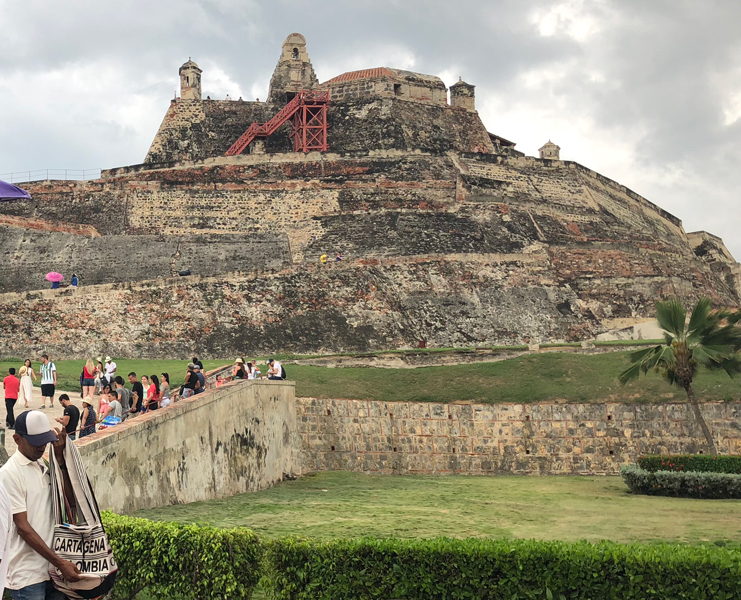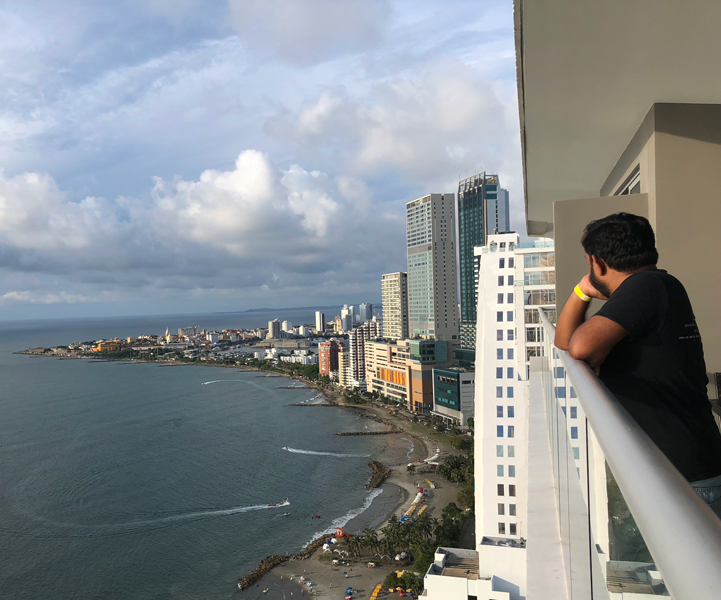Imagine coming across an article titled “How to stay safe in Colombia”, with the preamble running thus: “Cartagena (the beautiful port city of Colombia) has been the focus of a crackdown by the authorities on sex tourism and attacks against foreigners”, when you are planning a trip to Colombia, notorious for its drug trafficking and mafia bosses. The article goes on to describe the plight of a tourist who lands on Colombia’s beach paradise called Cartagena (pronounced Cartahena) only to find his wallet with money, credit cards and passport stolen the very first day. And if it stops with this, he will be lucky, says the article. Because there have been ample cases of tourists not only robbed but also beaten badly.


Luckily we saw this article in a local newspaper that my newspaper-crazy husband managed to find in English, only on the last day of our six-day dream holiday in this South American country.
Cartagena, Colombia’s port city located in the north on the Caribbean coast, with its spectacular beachfront dotted in a perfect semicircle by glittering modern skyscrapers, but where the city authorities have taken care to preserve its invaluable heritage, is a great holiday destination.
We zeroed in on Colombia through a flash decision while visiting our son in Mexico. When plans are made all of a sudden to go to a new country, these days we, Indian passport holders, have the option of choosing one of many countries that do not require a visa provided you have US or Schengen visa stamped on your passport. Two years ago, we chose Costa Rica for that very reason and this time we zeroed in on Colombia, as a five-hour flight from Mexico City takes you to Bogota, the capital and then another two-hour flight to Cartagena.

A greenhorn at the Avianca check-in counter at the Mexico airport demanded to see our Colombian visa, but armed with the knowledge, and that too from the Colombian government’s official website that Indians holding either a US or Schengen visa with 180 days validity enjoy a visa exemption, we showed him the snapshot and were cleared to board our flight!
We had booked a nice Airbnb apartment on the 22nd floor in a swank high-rise building bang on the beachfront, and were blown away by the fantastic view of the Caribbean coast and the waterfront it provided.
Cartagena has undoubtedly emerged as one of South America’s most vibrant cities — and a jewel on Colombia’s northern coast. It has on offer an exciting bouquet; ranging from fine dining options which will pinch your pockets, to much cheaper but delicious street food, including the most refreshing fresh fruits such as mango, banana, papaya and pineapple, which grow in abundance here. While for the younger tourists, beach parties are the hip-hop places to hang out in (but they would be well advised to carry only sufficient money necessary for one evening), the most iconic part of Cartagena which exudes over 500 years of history — piracy, wars, slavery — is the walled city.

If you are not too much a beach person and a bar hopper, then you have to head in Cartagena straight to its charming old city or walled town filled with colourful and buzzing cafes, cobbled streets, and shops filled with curios and eager tourists. One of the main attractions of the walled city is the Castillo San Felipe.
This is an impressive fortress, work on which was begun in the 16th century but it continued to be expanded and renovated in the next two centuries. Built in the shape of a pyramid, it was named thus to honour Philip IV, King of Spain and Portugal. During its expansion, its progressive defence systems were incorporated to cut off the advance of the enemy to the fortified plaza. From its underground network of galleries, mines could be detonated to explode the land under the assailants. It is a living witness of the fear psychosis of a people and region plagued by 300 years of attacks, wars and slavery.
After a tour of the Castillo, as you walk down, you will find an army of hawkers peddling colourful and lovely handicrafts and souvenirs such as fine hats, magnets, masks, ear rings, necklaces, and similar ware. But opt to shop from the hawkers only if you have a stomach for fierce bargaining. The best way to see the walled city is to walk around. Prepare to be enchanted by its colourful, colonial buildings painted in bright, but not garish, colours with flowers hanging from bright pink and yellow balconies, and seductively lit stone archways. Don’t miss to give a close look to the architecture of the buildings, which is intricate down to the beautifully designed door handles.

But compared to the beachfront and the more modern part of Cartagena, the walled city is pretty pricey. You just have to walk around the area to find stunning hotels and cafes on almost every street. There is no better way to spend an hour or two than sitting in one of the cafes sipping a delicious Colombian coffee, or guzzling beer, depending on whatever your poison is. But when the cheque arrives, you’ll realise that the old city is meant for the upmarket traveller.
After Cartagena, we went up to Bogota, which is one of the highest capitals in the world, located at a height of around 8,500 ft above sea level. The friendliness of the Colombian people we had sampled in Cartagena, but what we encountered in Bogota took our breath away. It was an early morning flight which brought us to Hotel Eldorado at 9 am, and gingerly we put in request for early check-in, expecting to be charged for half a day as the check-in time at most hotels is 2 pm. Spanish being the language of Colombians, English speaking is confined to hotels and tourist spots. But the lady at the front desk not only spoke fluent English, she smiled and said: “I can see how tired you are” and pronto, handed us the keys to both the rooms.
Bogota is a picturesque mountain town with salubrious climate, we chose a tour of the Monserrate mountain that dominates the city centre, rising to a height of around 10,200 ft, with a church at its highest point. Tourists flock to Monserrate for its natural beauty as well as history; it was considered an important sacred place in the city before the arrival of the Spanish: the local Muisca indigenous people called the mountain quijicha caca, or grandmother’s foot, and considered it a sacred place because the sun rises directly behind the mountain during the solstice in June. Later a church with a shrine was built here.
Many tourists, especially pilgrims, walk up the distance but we took the rail funicular and landed straight into biting cold winds and freezing temperature. But the spectacular view of this beautiful city that you can see from this charming spot, with a very strong Christian theme and depiction of the crucifixion of Christ through moving sculptures leading up to the church, is worth a visit.
A must place to walk around in downtown Bogota is the main square or Plaza de Bolivar with imposing buildings including a cathedral. Just walking around this giant square gives you a feel of the city, and there are literally thousands of pigeons flying all over the place waiting to be fed. An open-air art exhibition was on when we visited it and it was a special treat to be able to see replicas of great masters such as Raphael and Rubens.
The little streets that branch out from this square are a shopper’s delight; embroidered cloth bags and purses, cushion covers and serviettes, masks and figurines, and other handicrafts, particularly pottery and masks, are available at reasonable prices. In contrast to the hawkers in the walled city of Cartagena, the women and men manning these shops were extremely polite, friendly and pleasant. You didn’t get the feeling that they were out to fleece tourists, could converse in decent English, eagerly showed their wares and displayed not the least bit of irritation when you did not buy something. And when I asked to buy a particular kind of handicraft, one of the women manning a shop walked for about five minutes to accompany me to the place.
A tourist is bound to come away from Colombia with warm feelings and pleasant memories about its friendly people. Yes, there is poverty here; yes, if you want to take photos with a traditionally and colourfully dressed local woman in the walled city, you have to part with an equivalent of ₹100 or a little more, but do remember that these women make a living out of providing photo-ops to tourists.
Much more than anything else, Colombia is famous for both its chocolates and coffee; pick up both in generous quantities. Colombian coffee will infuse your entire house with its fragrance and remind you of the beautiful country and its people for long after you return home.
Pictures by Rasheeda Bhagat





